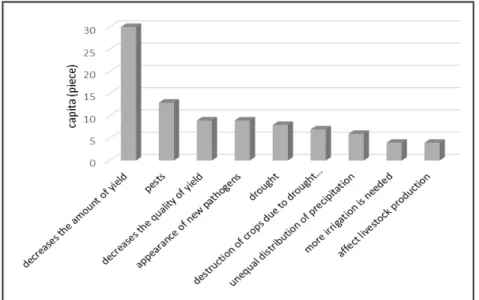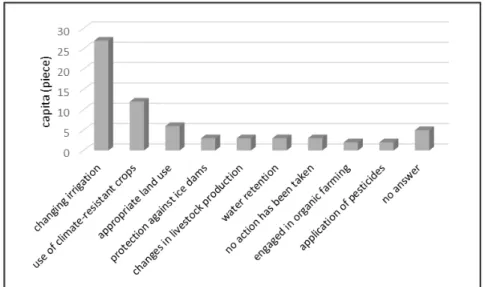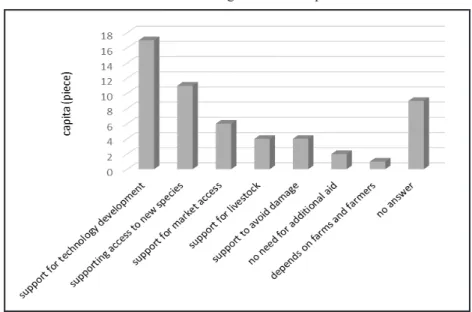Climate consciousness and adaptation from the viewpoint of farmers
Jenő Zsolt FARKAS1 – Edit HOYK2
1: Institute for Regional Studies, Centre for Economic and Regional Studies, Hungarian Academy of Sciences;
E-mail: farkasj@rkk.hu
2: Institute for Regional Studies, Centre for Economic and Regional Studies, Hungarian Academy of Sciences;
E-mail: hoyk.edit@krtk.mta.hu
Abstract: Adaptation to climate change and finding solutions to the environmental consequences are urgent tasks.
The role of farmers in the adaptation is essential, that is why beliefs of farmers in this theme are important. In our work we give an overview about the opinion, knowledge and attitude of farmers in relation to climate change.
We revealed their knowledge and individual insights with questionnaires. 50 farmers from the area of Kiskunság participated in it. Our aim with the questionnaire was to assess the farming community’s information about the climate change, explore the changes in their natural environment and actions against unfavourable trends. In addition, we tried to get answers about what kind of assistance the producers require to overcome these problems in the future. Beside the questionnaire we interviewed large agricultural entrepreneurs, agricultural public administration employees and agricultural intellectuals about the effects of climate change in the agriculture.
We found that farmers are mostly waiting for outside help for resolving their problems, in the form of financial support and a solution for the problem of irrigation. It is highlighted that up-to-date knowledge and flexibility are needed in order to prevent damages. It means adequate production technology and farming practices instead of only increasing the monetary aid.
Keywords: adaptation, agriculture, climate awareness
Introduction
Nowadays, it is an established fact – not only in Hungary, but in the world –, that the climate sensitivity of many regions is high, and big territories are vulnerable to global warming and climate extremes. One of the most sensitive field is the agriculture. That is way vulnerability and adaptation are in the focus of the international literature recently (Tripathi – Mishra, 2016; Ayanlade et al. 2016; Khatri-Chhetri et al. 2017). The topic receives a special attention also in Hungary (Li et al. 2016; Birkás 2010; Soltész et al. 2011). On the base of the climate models, Hungary is in water deficiency more and more – summers become drier, the length and frequency of droughts are increasing. The expected changes are only the most anticipated processes. Besides these countless other unexpected effects may also arise, which can disrupt the delicate environmental balance of our landscapes. Involvement in agriculture is significant, therefore one of the most important questions of the future: how can the Hungarian agriculture and forestry adapt to the constantly changing microclimate in the next decades? How the entrepreneurs, interested in agricultural production, will be able to climate conscious thinking and how can they eliminate threats? In summary, what can the farmers do in the changing environment in order to maintain the values of agriculture and rural life – so what new alternatives and methods will be needed to preserve for successful land management? The role of farmers in the adaptation is significant;
therefore their beliefs in this theme are important. In our work we give an overview about the opinion, knowledge and attitude of farmers in relation with climate change.
Materials and methods
We revealed the knowledge of farmers and their individual insights with questionnaires.
50 farmers from the area of Kiskunság participated in the survey, which is not considered
representative, because a significant portion of the respondents are biofarmers, or family farmers with climate conscious production practices. Consequently they are more informed and more sensitive about changes in production circumstances in their work.
Our aim with the questionnaire was to assess the farmer community’s information about the climate change, explore the changes in their natural environment and their actions against unfavourable trends. In addition, we tried to get answers about what kind of assistance the producers require to overcome these problems in the future.
Besides the questionnaire we interviewed large agricultural entrepreneurs, agricultural public administration employees and agricultural intellectuals about the effects of climate change in the primary sector. Altogether 14 conversations have been processed and we tried to achieve large national territorial coverage (from Baranya to Hajdú-Bihar counties).
The results described in this paper were made within the “Climate change and rural development – the effect of global warming on land use changing” scientific project, which was part of the “Rural research 2012-2013” programme, financed by Hungarian National Rural Network (MNVH), National Agricultural Advisory, Education and Rural Development Institute (NAKVI) and Hungarian Academy of Sciences (MTA).
Results and discussion
In our paper we highlight the most notable answers from the results of questionnaires.
The interviewed farmers are working in the Homokhátság territory. Without exception all of them stated, that the condition of the landscape on Danube-Tisza Interfluve is rapidly deteriorating and the effects of climate change are well detectable. The experienced changes in their environment are the following: weather extremes, drought and uneven distribution of the precipitation.Respondents pointed to the declining yields especially, which is the most palpable consequence of the climate change during their farming (Fig. 1.).
Figure 1.: Detected effects in the respondents’ own farm
According to the farmers in the Kiskunság area, lower yield unfortunately also means lower quality. The unanimous response is: extremes of recent years influenced farming practices in the wrong direction. Respondents highlighted among the expected negative aspects that year after year more chewing and sucking pests can be found, pathogens proliferate, weeds spread intensively and more and more new species appear.
The actions, which have been already taken by the farmers to counterbalance the unfavourable changes, are important indicators of the future adaptation prospects. On the basis of their answers, they try to compensate the negative effects with changing the method and quantity of the irrigation (Fig 2.).
The interviews responses suggest that the large agricultural entrepreneurs try to change agricultural technology and to mainly use drought tolerant species. Many interviewed mentioned that they increased their irrigated area, or built ice nets in orchards. They use polymerized, encapsulated, or organomineral fertilizers and pesticides, which gradually migrate into the soil. Many farmers apply the mulch technology because the mixed crop residues on the soil retain water content.
It is definitely positive, that some of the respondents – in addition to irrigation and change of species – are also trying to adapt to the weather extremes with using appropriate land use, cultivation or soil coverage. They realised that it is in their interest to improve the air and water supply of the soil, or the reception and preservation of precipitation.
It suggests that farmers in the Danube-Tisza Interfluve now recognized the importance of rational management of the available water resources. At the same time, the construction of irrigation systems also enjoys a prime location among the actions planned in the future.
It shows that the farmers still see irrigation as a key solution to water scarcity.
Those farmers, who do not dare to spend too much money for a bigger development, trying to focus more on selection of fertile materials. Because of this, they plan the acquisition of drought tolerant species. There were some farmers, who partially plan the change-over
Figure 2.: Actions taken against the effects of the climate change
are some farmers, who feel that they do not have enough information for the cultivation of new, drought tolerant species. Agricultural public administration employees primarily highlighted the role of water retention and water management.
Over half of the interviewed farmers did not ask for help from anywhere so far, in order to solve the problems of global climate change. Most farmers informed themselves individually (mainly from the media) and they try to overcome obstacles with their own power. Those who used some support turned for information and advice to the consultants of National Association of Agricultural Economics.
In response to the question “what kind of support they expect in the interest of successful adaptation in the future”, respondents highlighted technological development (which mostly means irrigation technology) and support for accessing new plant species (Fig. 3.).
The answers of the farmers show the recognition of the problems related to the climate
change but also show they do not have enough information about the various solution possibilities. From our results we can clearly see that the farmers get their information mainly from the media because there are no other easily available information sources despite of the demand.
Besides the demand for consultancy and information services the farmers think a new water governance system should be introduced in the Danube-Tisza Interfluve to maintain and secure the production output of the primary sector. In their opinion this new water governance should include new irrigation channels and maintenance of the existing ones which highlight the fact they would like to solve the water scarcity and aridity problems with new water supplies (e.g. from Danube). In accordance with the EU strategy for the 2014-2020 period we can recommend the following actions for a successful adaptation process:
Figure 3: Importance of subsidies according to farmers
• introduction of a new land use system which is in line with the environmental conditions,
• new research programmes to identify the long-term social and economic effects of the new planned land use system,
• new insurance and risk management system to counteract the negative effects of climate change for the producers and the rural population too,
• introduction of new innovative technologies and raising the proportion of renewable energy consumption in the primary sector,
• strengthening of agro-environmental and climate protection targets and subsidies within the CAP.
In addition to the above mentioned recommendations, to make the adaptation process successful, the public administration and the farmers need information and instructions what to do at a local or personal level. These can form the base or the starting point of a broader change in the production and the land use system too.
In the area of Homokhátság significant investments are needed because of the special environmental, economic and social conditions. The complex elements of this development process can be the following: introducing a water retention system with new water governance which involves infrastructural and institutional investments, improving internal and external accessibility of the region, promoting the use of renewable energy resources and utilization of its bioenergetics potential.
Conclusions
Agriculture is one of the key areas for the successful adaptation to climate change. This success is mostly depends on the farmers and on their knowledge and actions. That’s why it is important especially in the case of Hungary to provide the producers with information and possible adaptation strategies which they could use in the everyday production.
The producers wait for the help of the state in this question, and it is important to know they demand more subsidies and solutions for the water scarcity. Also they would like to get the support of the municipalities and the local societies especially in the question of irrigation water. This means they would like to reduce the price of irrigation water and to build and maintain new irrigation channels. This situation would be optimal for the producers but it will not encourage activities related to water retention or reduce water demand and the overall sustainability of agriculture will not improve. The producers have to consider new methods and technologies because of aridity before they demand new water supplies for the area.
These facts show that the first step to a successful adaptation is to change the attitude of the farmers and raise their climate awareness. During this learning process we think they will understand the subsidies will not solve their problems in the long term. The consumers can also contribute to this above mentioned transition. It is obvious nowadays that consumers looking for healthy products, but they can also take into account other aspects such as whether a product is climate friendly or not. So the technological changes in the production should be ensured not only with regulations and subsidies but also with building demand for products which are produced in a sustainable way. This can generate
The producers have to be interested in the damage prevention related to the effects of the climate change such as extreme weather conditions. This is important from the aspect of mutual responsibility and insurance costs in the primary sector, which can rise rapidly in the future. The farmers can reduce these costs by changing their activities based on new scientific results for example if they switch to the production of drought tolerant crops.
The National Rural Strategy for 2012-2020 also states that the conservation of natural resources and values are the most important strategic task of a sustainable agricultural and rural development policy. The agricultural output can be increased in the future but the producers must take the environmental conditions into account and have to apply sustainable land use management techniques in their activities.
References
Ayanlade, A., Radeny, M., Morton, J.F. (2016): Comparing smallholder farmers perception of climate change with meteorological data: A case study from southwestern Nigeria. Weather and Climate Extremes, in press.
DOI: http://dx.doi.org/10.1016/j.wace.2016.12.001
Birkás, M. (2010): A klímaváltozás hatása a növénytermesztési gyakorlatra. In: Rakonczai J. (szerk.): Környezeti változások és az Alföld. Nagyalföld Alapítvány Kötetei 7. 257-270.
Khatri-Chhetri, A., Aggarwal, P.K., Joshi, P.K., Vyas S. (2017): Farmers’ prioritization of climate-smart agriculture (CSA) technologies. Agricultural Systems, Volume 151, 184–191. DOI: http://dx.doi.
org/10.1016/j.agsy.2016.10.005
Li, S., Juhász-Horváth L., Harrison, P.A., Pintér, L., Rounsevell, Mark D.A. (2016): Relating farmer’s perceptions of climate change risk to adaptation behaviour in Hungary. Journal of Environmental Management. Volume 185, 21–30. DOI: http://dx.doi.org/10.1016/j.jenvman.2016.10.051
Soltész, M., Nyéki, J., Lévai, P. (2011): Az aszály és szárazodás elleni küzdelem a kertészeti termelésben. –
„Klíma-21” Füzetek, 64. 5–11.
Tripathi, A., Mishra, A.K. (2016): Knowledge and passive adaptation to climate change: An example from Indian farmers. Climate Risk Management, in press. DOI: http://dx.doi.org/10.1016/j.crm.2016.11.002


